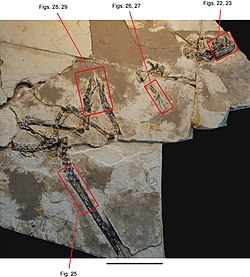Tianyulong
|
Tianyulong Temporal range: Late Jurassic, 158.5 Ma |
|
|---|---|
 |
|
| Specimen IVPP V17090, muzzle, hand, feet and tail framed in red | |
| Scientific classification | |
| Kingdom: | Animalia |
| Phylum: | Chordata |
| Class: | Reptilia |
| Clade: | Dinosauria |
| Order: | †Ornithischia |
| Family: | †Heterodontosauridae |
| Genus: |
†Tianyulong Zheng et al., 2009 |
| Species: | †T. confuciusi |
| Binomial name | |
|
Tianyulong confuciusi Zheng et al., 2009 |
|
Tianyulong (Chinese: 天宇龍; Pinyin: tiānyǔlóng; named for the Shandong Tianyu Museum of Nature where the holotype fossil is housed) was a genus of heterodontosaurid ornithischian dinosaur. The only species was T. confuciusi, whose remains were discovered in Jianchang County, Western Liaoning Province, China.
The fossil was initially reported as being from the Early Cretaceous Jehol group. The fossil was collected at a locality transliterated as Linglengta or Linglongta. Lu et al., 2010, reported that these beds were actually part of the Tiaojishan Formation, dating from the late Jurassic period at least 158.5 million years ago.
Tianyulong has a row of long, filamentous integumentary structures on the back, tail and neck of the specimen. The similarity of these structures with those found on some theropods suggests their homology with feathers and raises the possibility that the earliest dinosaurs and their ancestors were covered with homologous dermal filamentous structures that can be considered primitive feathers ("proto-feathers").
The holotype consists of an incomplete skeleton preserving a partial skull and mandible, partial presacral vertebrae, proximal–middle caudal vertebrae, nearly complete right scapula, both humeri, the proximal end of the left ulna, partial pubes, both ischia, both femora, the right tibia and fibula and pes, as well as remains of long, singular and unbranched filamentous integumentary structures. The holotype is from a subadult individual that probably measured 70 cm in length based on the proportions of the related South African species Heterodontosaurus tucki.
...
Wikipedia
